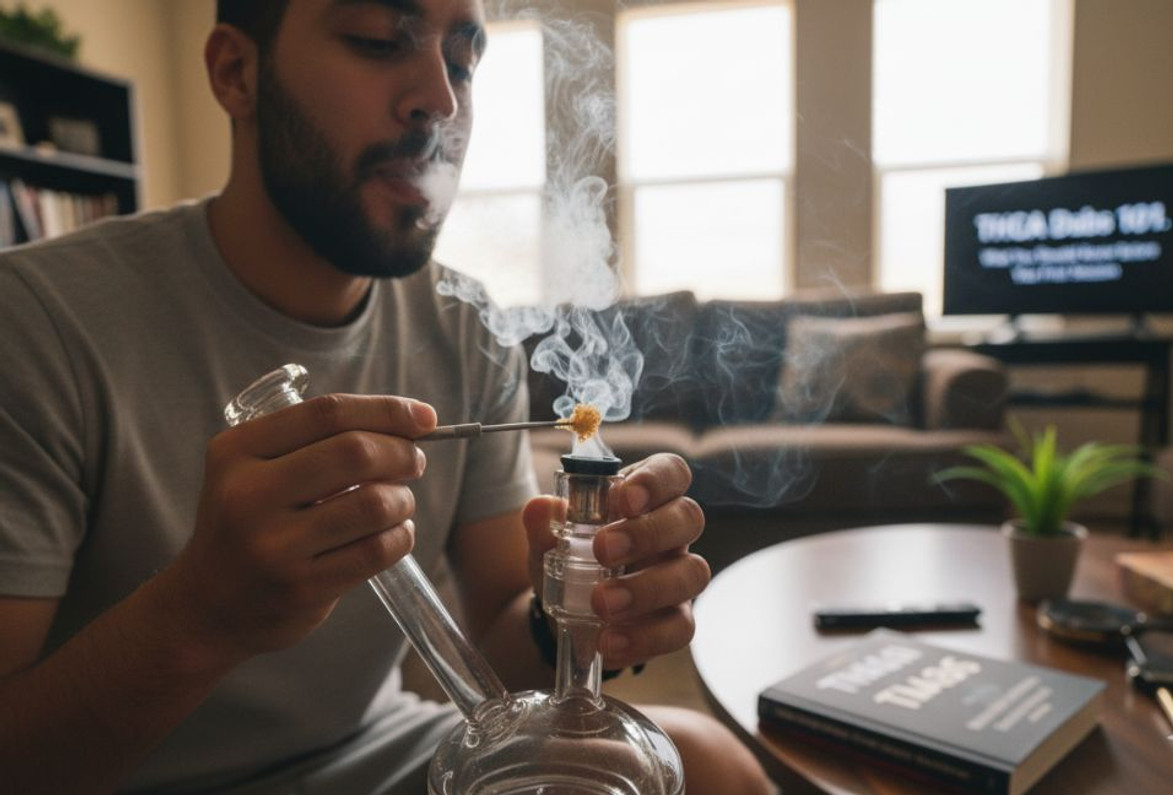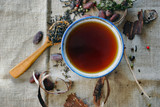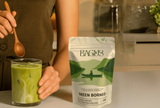THCA Dabs 101: What You Should Know Before Your First Session
THCA dabs are hemp concentrates that come in textures like badder, live sugar, and diamonds. They’re popular because they provide a concentrated form of THCA with third-party lab results for transparency.
Here’s what we’ll cover in this guide:
- What THCA dabs are and why people use them
- The differences between textures like badder and live sugar
- How to read lab results and understand product transparency
- Practical tips for your first dab session
At The Calm Leaf, we know that stepping into concentrates can feel overwhelming. Between names like badder and live sugar, it’s easy to get lost in terminology. That’s why this guide focuses on clarity. Every product in our THCA concentrates collection comes with third-party lab testing, so you know exactly what you’re getting.
What Are THCA Dabs?
If you’ve only handled raw hemp before, dabs can look almost unrecognizable. Instead of ground flower, you’re holding a dense concentrate that’s been carefully refined. The process strips out excess plant material, leaving you with a potent expression of THCA in a condensed form. Some people gravitate toward cannabinoids in their raw form, but concentrates take it a step further by focusing on one compound in a way that flower can’t.
You’ll also notice how flexible dabs are. You can pick up concentrates that feel whipped and creamy, like badder or crystalline and grainy like live sugar. Each texture has its quirks: badder holds together like soft butter, while sugar granules almost sparkle under light. If you’re used to buying hemp flower, the jump to these textures feels dramatic, but once you’ve seen both side by side, you get why people talk about them separately.
Types You’ll See Often
- Badder: a smooth, pliable concentrate with a whipped consistency.
- Live sugar: granular, sugar-like crystals coated in terpenes.
- Diamonds: solid chunks of crystallized THCA, usually with a saucy mix around them.
The texture reflects how the extract was processed. For example, live sugar usually comes from fresh-frozen material, while badder gets its creaminess from being whipped during refinement.
Quick Comparison
|
Texture |
What it Looks Like |
Why People Pick It |
|
Badder |
Soft, creamy whip |
Easy to handle and measure |
|
Live Sugar |
Grainy crystals |
Bold aroma with rich terpene coating |
|
Diamonds |
Solid crystals |
Highly concentrated form of THCA |
What is THCA Badder
THCA badder is a whipped concentrate with a soft texture that makes it easy to handle. It’s one of the most approachable options for beginners who want a balance of usability and terpene character.
Badder looks different from other concentrates right away. Instead of sugar-like crystals or solid chunks, it spreads almost like cake frosting. That soft consistency makes it less intimidating when you’re first getting into dabs. You don’t have to break apart big shards or scrape loose granules. Instead, it scoops and portions smoothly, which is why many people view it as a natural entry point.
When you see an option like After Hours THCA 4g Badder, you notice two things quickly: the size and the consistency. A larger jar means you can portion without running out fast, and the texture stays uniform throughout. On the other hand, a product such as the Elyxr 80% THCA full spectrum live resin badder adds another layer by combining THCA with a terpene-rich resin base.
Why Badder Appeals to Beginners
- Easy to scoop and portion without tools slipping
- Consistent texture from the first jar opening to the last use
- Often sold in larger sizes, giving more room to practice with
- Available in varieties that highlight terpene complexity without being tricky to handle
Lab reports play a role here, too. At The Calm Leaf, every option we stock carries verified third-party results. That way, when you’re deciding between a 4-gram jar and a smaller resin-based badder, you can actually see cannabinoid percentages and terpene breakdowns.
THCA Live Sugar
THCA live sugar is a concentrate with a crystal-coated texture that’s sticky, aromatic, and packed with terpenes. It’s made from fresh-frozen material, which preserves plant compounds that cured extracts can sometimes lose.
When you first see live sugar, it almost looks like wet, golden grains clumped together. That grainy, crystal-like appearance isn’t random; it comes from how THCA crystallizes during extraction. The sticky consistency is what sets it apart from smoother forms like badder. You’ll notice it clings to tools, and the granules shimmer a little under light.
Some of the standout options include the Elyxr THCA Private Reserve live rosin sugar, which brings in a small-batch rosin extraction, and the Tabease THCA diamond sugar badder that blends crystalline formations with whipped badder for a textured mix. That combination gives you something that’s not just sugar, not just badder, but a hybrid between the two.
Why People Choose Live Sugar
- Bold terpene presence that carries a strong aroma
- Crystalline structure that feels distinct compared to whipped badder
- Sticky enough to stay on tools without scattering everywhere
- Often made from fresh-frozen hemp, keeping natural compounds intact
The way it’s made matters. Instead of drying and curing the hemp first, the plants are frozen right after harvest. That technique captures terpenes that might otherwise degrade, which is why live sugar often smells more pungent than other concentrates.
Live Sugar Compared to Other Concentrates
|
Concentrate |
Texture |
Why It Stands Out |
|
Badder |
Soft, whipped |
Easy to scoop and portion |
|
Live Sugar |
Granular, sticky |
Strong terpene presence, bold aroma |
|
Diamonds |
Solid crystals |
Dense crystallized THCA content |
After Hours THCA Options
After Hours THCA concentrates are known for larger jars, smooth consistencies, and lab transparency. Their badder, in particular, has become popular with people who want a concentrate that’s both practical in size and consistent in texture.
When you open a jar of After Hours THCA 4g Badder, you immediately notice the generous portion. Four grams is more than the standard size you’ll see with many concentrates, which means you can portion out dabs over a longer stretch without restocking too soon. It’s not just about quantity, though. The badder itself spreads evenly from edge to edge, and that consistency stays intact even after multiple uses.
Why After Hours Badder Stands Out
- Larger jar size than most competitors
- Soft, whipped texture that holds uniform shape
- Easy to portion without crumbling or separating
- Backed by lab testing for cannabinoid and terpene data
It’s also worth noting that After Hours products line up with the same third-party testing standards you’ll find across The Calm Leaf. Certificates aren’t buried in fine print; they’re available for you to check before buying. That kind of transparency gives you the data you need, percentages, terpene content, and proof that the concentrate meets state requirements.
Tips for Your First Dab Session
Start your first THCA dab session by focusing on temperature control, portion sizing, and product type. These three things matter most for beginners who want clarity, consistency, and less waste when working with concentrates.
Temperature Changes
One of the easiest mistakes to make is going in too hot. Temperature changes everything. If you overheat your concentrate, it can scorch the product, which is why tips to avoid burning your dabs exist. Lower heat usually preserves terpenes better and makes the session more manageable. You’ll know you’ve overheated when the concentrate leaves behind black residue instead of a clean surface.
Portion Sizing
The second factor is portion sizing. Don’t let a big jar fool you. That badder may look like it can handle scoops the size of a marble, but smaller servings go a long way. Beginners often waste product by starting with more than they actually need. A rice-grain amount is often enough to test the waters; anything more is just excess.
Product Type
Product type is the third detail you can’t ignore. A sugary mix like the Tabease diamond sugar badder behaves differently from smooth whipped badder. Sugar can cling to tools in sticky clumps, while whipped badder spreads easily. If you’re unsure, consider the best THCA dabs for 2025 to compare which textures are receiving strong feedback.
Quick Tips That Actually Help
- Check your tool size: smaller scoops give you more control.
- Keep a cotton swab nearby: wipe after each dab so residue doesn’t build up.
- Stick to one texture at first: switching between sugar and badder can make consistency harder to gauge.
- Review lab results before buying: our THCA concentrates lists third-party reports for transparency.
And here’s something you might not think about until it happens: dabs can get messy. Sticky sugar on a glass tool or leftover residue on a surface can ruin the experience. Having isopropyl wipes ready makes cleanup fast.
Your Concentrate Search Starts Here
The best way to start with THCA dabs is to pick textures that match your style and stick with brands that publish clear lab results. That mix of choice and transparency makes every purchase easier.
We’ve walked through what makes badder soft and spreadable, why live sugar sparkles, and how diamonds form in crystal-heavy jars. If you’ve been curious about larger jars, options like After Hours badder give you more room to practice. If you like textures that mix crystal and cream, blends such as Tabease diamond sugar badder might fit better. Or maybe you’re browsing all the choices in the THCA concentrate collection.
Frequently Asked Questions
What makes THCA dabs different from regular concentrates?
THCA dabs are focused on tetrahydrocannabinolic acid in its concentrated form, while other concentrates might highlight different cannabinoids or mixed profiles. This means you’re often dealing with products that showcase raw THCA before conversion. Regular concentrates, like CBD wax or CBG isolates, are made with different goals in mind. That’s why the label matters; you need to know exactly what compound you’re getting. Lab reports usually make that clear.
How should you store THCA dabs to keep them fresh?
Temperature and light exposure are the biggest factors. Keep your dabs in a cool, dark place, ideally in their original container with the lid sealed tight. Some people use small silicone jars, but glass tends to preserve texture better over time. If you leave badder exposed, it can dry out and lose its whipped consistency. Sugar textures can clump if they sit in the heat.
Why do some THCA dabs look darker than others?
Color differences often come from the starting material or how the extract was processed. A lighter golden badder usually means fresher input material or careful whipping. Darker shades can still be fine, but might show longer curing or more oxidation. It doesn’t automatically mean lower quality; it’s just part of natural variation. Always check the lab results to confirm cannabinoid levels regardless of color.
Are THCA dabs legal everywhere hemp is legal?
They fall under hemp regulations in most U.S. states if they meet the federal 0.3% delta-9 THC limit. But some states have stricter rules on concentrates, even if they’re hemp-derived. That’s why legality can shift depending on where you live. It’s worth checking your state’s most recent updates before placing your order. Laws surrounding concentrates often change more rapidly than those surrounding raw flower.
Do different textures of THCA dabs taste different?
Yes, the texture plays a role in how terpenes are preserved and presented. Live sugar, for example, usually has a more pungent aroma because it’s made from fresh-frozen material. Badder has a smoother consistency that can feel lighter on the palate. Diamonds often come with a terpene sauce that changes the overall flavor profile. So, while it’s the same cannabinoid, the texture changes the sensory experience.
How important are lab reports when buying THCA dabs?
They’re non-negotiable. Lab reports confirm cannabinoid percentages, terpene content, and that no harmful residues are present. Without them, you’re basically guessing at what you’re buying. Reputable retailers post reports directly on product pages so you don’t have to ask. It’s the simplest way to confirm authenticity and quality.
What’s the difference between THCA diamonds and badder?
Diamonds are solid crystals of THCA, usually dense and shard-like, often paired with a terpene-rich sauce. Badder, on the other hand, is whipped into a soft, creamy texture. Diamonds usually have a higher THCA concentration in raw form. Badder is easier to handle and portion. Many people start with badder for convenience and add diamonds later when they’re curious about crystal-heavy textures.
Do THCA dabs expire?
They don’t expire like food, but they do degrade. Over time, heat and light can cause cannabinoids to convert and terpenes to evaporate. A badder that once spread smoothly might harden after months on a shelf. Live sugar can clump and lose its aroma. If stored properly, though, most concentrates hold up well for several months to a year.
Why do some jars list “live” before badder or sugar?
“Live” usually means the concentrate was made from fresh-frozen hemp rather than cured material. Freezing right after harvest helps lock in terpene content. That’s why live products often smell stronger than their cured counterparts. It’s not a marketing gimmick; it reflects the extraction method. Reading product labels carefully helps you spot this distinction.
Is there a difference in how THCA dabs are priced?
Yes, pricing often reflects both size and process. A 4-gram jar like those from some brands will naturally cost more upfront, though it may last longer. Live resin or rosin-based products are usually more expensive because they take more work to produce. Smaller jars are often cheaper but run out faster. You’ll notice price shifts tied to both jar size and the extraction method.
Recent Posts
-
Something to Sip On: Cannabinoid-Infused Teas vs. Kratom-Infused Teas
The simple act of brewing a cup of tea is a ritual that connects us to thousands of years of human h …Dec 03, 2025 -
What Does "Premium" Mean When it Comes to Kratom Products?
In the broadly ever-expanding marketplace of modern consumer goods, "premium" is a word that carries …Nov 30, 2025 -
What is the Typical Percentage of Mitragynine Used in MIT Tablets?
The world of botanicals is in the midst of a profound transformation. Ancient plants, once used in t …Nov 27, 2025



